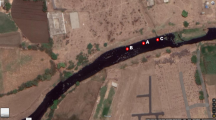Abstract
In this study, capture simulation of space debris in various motions is conducted using a space-net. A nonlinear structural dynamics analysis code, ABAQUS, is used in the capture simulation. A general contact method is used to represent both the contact between the space-net and space debris, and the self-contact of the space-net. The space debris is assumed to be a rigid body with the shape of a 12U cube-sat. The space-net is shaped as a 2 × 2 m square and modeled using nonlinear finite beam elements. The present capture simulation techniques are validated through a comparison with a capture test from a previous study. In the capture simulations, first, the process of capturing space debris in cooperative motion is understood. Second, the space-net is simulated to capture space debris in non-cooperative motion. Results show that the rotation about the z-axis contributes significantly to the rotational component of the space debris in non-cooperative motion for a successful or unsuccessful capture.




















Similar content being viewed by others
References
NASA Orbital Debris Program Office (2020) Astromaterials research & exploration science. https://orbitaldebris.jsc.nasa.gov/modeling/legend.html. Accessed 12 Jan 2022
Kessler DJ, Cour-Palais BG (1978) Collision frequency of artificial satellites: the creation of a debris belt. J Geophys Res 83:2637–2646
Garcia M (2021) Space debris and human spacecraft. NASA. https://www.nasa.gov/mission_pages/ station/news/orbital_debris.html. Accessed 27 May 2021
Liou JC (2011) An active debris removal parametric study for LEO environment remediation. Adv Space Res 47(11):1865–1876
Nishida SI, Kawamoto S, Okawa Y, Terui F, Kitamura S (2009) Space debris removal system using a small satellite. Acta Astronaut 65(1–2):95–102
Aglietti GS, Taylor B, Fellowes S, Salmon T, Retat I, Hall A, Chabot T, Pisseloup A, Cox C, Zarkesh A, Mafficini A, Vinkoff N, Bashford K, Bernal C, Chaumette F, Pollini A, Steyn WH (2020) The active space debris removal mission RemoveDebris. Part 2: in orbit operations. Acta Astronaut 168:310–322
Benvenuto R, Lavagna M (2013) Flexible capture devices for medium to large debris active removal: simulations results to drive experiments. In: 12th Symposium on Advanced Technologies in Automation and Robotics, pp.1–8
Benvenuto R, Salvi S, Lavagna M (2015) Dynamics analysis and GNC design of flexible systems for space debris active removal. Acta Astronaut 110:247–265
Benvenuto R, Lavagna M, Salvi S (2016) Multibody dynamics driving GNC and system design in tethered nets for active debris removal. Adv Space Res 58(1):45–63
Shan M, Guo J, Gill E (2017) Deployment dynamics of tethered-net for space debris removal. Acta Astronaut 132:293–302
Lappas V, Forshaw J, Visagie L, Pisseloup A, Salmon T, Joffre E, Chabot T, Retat I, Axthelm R, Barraclough S, Ratcliffe A, Bradford A, Kadhem H, Navarathinam N, Rotteveel J, Bernal C, Chaumette F, Pollini A, Steyn WH (2014) RemoveDEBRIS: An EU low cost demonstration mission to test ADR technologies. In: International Astronautical Congress
Forshaw JL, Aglietti GS, Navarathinam N, Kadhem H, Salmon T, Pisseloup A, Joffre E, Chabot T, Retat I, Axthelm R, Barraclough S, Ratcliffe A, Bernal C, Chaumette F, Pollini A, Steyn WH (2016) RemoveDEBRIS: an in-orbit active debris removal demonstration mission. Acta Astronaut 127:448–463
Forshaw JL, Aglietti GS, Fellowes S, Salmon T, Retat I, Hall A, Chabot T, Pisseloup A, Tye D, Bernal C, Chaumette F, Pollini A, Steyn WH (2020) The active space debris removal mission RemoveDebris. Part 1: from concept to launch. Acta Astronaut 168:293–309
Golebiowski W, Michalczyk R, Battista U, Dyrek M, Wormnes K (2014) Reliable and efficient simulation of nets for active space debris removal purposes. In: Proc 12th International Symposium on Artificial Intelligence, Robotics and Automation in Space
Golebiowski W, Michalczyk R, Dyrek M, Battista U, Wormnes K (2016) Validated simulator for space debris removal with nets and other flexible tethers applications. Acta Astronaut 129:229–240
Shan M, Guo J, Gill E, Golebiowski W (2017) Validation of space net deployment modeling methods using parabolic flight experiment. J Guid Control Dyn 40(12):3319–3327
Shan M, Guo J, Gill E (2018) Contact dynamics on net capturing of tumbling space debris. J Guid Control Dyn 41(9):2063–2072
Hwang U-J, Jang M, Lim J-H, Shin H-C, Sim C-H, Park J-S (2022) Capture simulation study for space debris using space-nets. J Korean Soc Aeronaut Space Scie 50(6):435–444
Etter J, Hedding L (1992) An experimental investigation of the longitudinal dynamics of long Kevlar tethers. In: Astrodynamics Conference
Dassault Systèmes Simulia Corp (2014) Abaqus Theory Manual, Version 6.11
Brown IF, Burgoyne CJ (1999) The friction and wear of Kevlar 49 sliding against aluminium at low velocity under high contact pressures. Wear 236(1–2):315–327
Acknowledgements
The work was supported by the National Research Foundation of Korea (NRF) grant funded by the Korea government (MSIT) (NRF-2022M1A3B8076744).
Author information
Authors and Affiliations
Corresponding author
Ethics declarations
Conflict of Interest
The authors declare that there is no conflict of interest regarding the publication of this paper.
Additional information
Publisher's Note
Springer Nature remains neutral with regard to jurisdictional claims in published maps and institutional affiliations.
Rights and permissions
Springer Nature or its licensor holds exclusive rights to this article under a publishing agreement with the author(s) or other rightsholder(s); author self-archiving of the accepted manuscript version of this article is solely governed by the terms of such publishing agreement and applicable law.
About this article
Cite this article
Shin, HC., Jang, M., Hwang, UJ. et al. Capture Simulation Using Space-Nets for Space Debris in Various Motions. Int. J. Aeronaut. Space Sci. 24, 547–558 (2023). https://doi.org/10.1007/s42405-022-00540-w
Received:
Revised:
Accepted:
Published:
Issue Date:
DOI: https://doi.org/10.1007/s42405-022-00540-w




